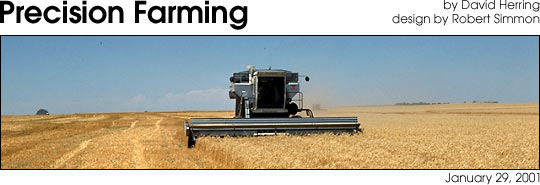

 |
Imagine you are a farmer riding along in your 50,000-acre wheat field early in the growing season. You push a button on your tractor to turn on its Global Positioning System (GPS) monitor, which pinpoints your exact location to within one meter. Touching another button, you display a series of Geographical Information System (GIS) maps that show where the soil in your field is moist, where the soil eroded over the winter, and where there are factors within the soil that limit crop growth. Next, you upload remote sensing data, collected just yesterday, that shows where your budding new crop is already thriving and areas where it isn’t. You hit SEND to upload these data into an onboard machine that automatically regulates the application of fertilizer and pesticides—just the right amount and exactly where the chemicals are needed. You sit back and enjoy the ride, saving money as the machines do most of the work. Congratulations, you are among a new generation of growers called "precision farmers." |
|||
|
|||
Does this sound like a science fiction scenario? It’s not. Even as you read this, there are already dozens of farmers around the United States and Canada who use satellite and aircraft remote sensing data to more effectively and efficiently manage their croplands. "Precision crop management is still in the experimental phase," states Susan Moran, a research hydrologist with the U.S. Department of Agriculture and member of the NASA Landsat 7 Science Team, based in Tucson, Arizona. "But there is a significant number of farmers who use high technology and remote sensing data for precision crop management." The U.S. Department of Agriculture, NASA, and NOAA are among key agencies contributing to this revolution in large-scale agriculture. The goal is to improve farmers’ profits and harvest yields while reducing the negative impacts of farming on the environment that come from over-application of chemicals. |
A new generation of farmers is using aerial and satellite remote sensing imagery (like this 4-meter resolution image from IKONOS) to help them more efficiently manage their croplands. By measuring precisely the way their fields reflect and emit energy at visible and infrared wavelengths, precision farmers can monitor a wide range of variables that affect their crops—such as soil moisture, surface temperature, photosynthetic activity, and weed or pest infestations. (Image copyright 2000 Space Imaging) | ||